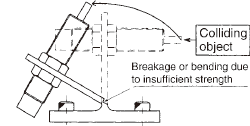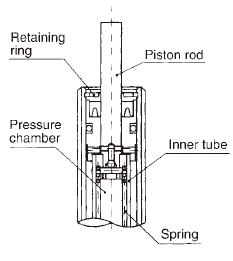Caution
Read these instructions before use
1. Definition of Warning
"Warning" applies to situations in which death or serious injuries may occur to the user, etc. if the potential
dangers of the products are not avoided.
2. Definition of "Caution"
"Caution" applies to situations in which minor injuries or property damage may result if the operation or
maintenance procedures are not strictly followed.
 Warning
Warning
Do not throw into a fire
- As the products contain oil, throwing them into a fire may cause them to ignite, resulting in injuries.
- Do not throw them into fire.
 Caution
Caution
Do not operate without sufficient mounting strength
- Operating with insufficient mounting strength may damage the main machine and cause injuries.
- Ensure sufficient mounting strength of maximum drag x safety factor (Regarding maximum drag, please refer to the catalogue or contact our sales department.)
Do not operate without an external stopper
- Without an external stopper, the main machine may become damaged due to bottoming (Note 1).
- Ensure that an external stopper is set in the prescribed location for each type before operating the product. (For the locations of external stoppers, please refer to the catalogue or to the owner's manual.)
Do not attach using incorrect tightening torque
- Using an incorrect tightening torque when attaching may cause operational failure and damage to the main machine.
- When tightening an attachment screw for a soft absorber, please use the tightening torque as listed below.
| External diameter of the screw (mm) |
M4
X
0.5 |
M6
X
0.75 |
M8
X
0.75 |
M10
X
1 |
M12X1
M12X1.75 |
M14X1.5
M14X2.0 |
M16X1.5
M16X2.0 |
M20
X
1.5 |
M25X1.5
M25X2 |
M27X1.5
M27X3 |
M30
X
1.5 |
M36
X
1.5 |
M42
X
1.5 |
| Tightening torque for the bolt (N·m) |
0.35 |
0.85 |
3.9 |
7.8 |
7.8 |
9.8 |
14.7 |
29.4 |
49 |
58.8 |
78.4 |
98 |
392 |
* Using an adhesive is an effective way to prevent loosening.
*Tightening torque: 1.5Nm (excluding FA-1212C)
Dislodged retaining ring
- Failure to adhere to the specifications listed in the catalogue may cause the internal pressure of the inner tube to raise to a dangerous level where the retaining ring may become dislodged and interior parts may shoot out,causing injuries.
- Do not bring your face close to a soft absorber that has a retaining ring while it is operating.
Do not discard oil more than is necessary
- Discarding the oil contained in soft absorbers more than is necessary will pollute the environment.
- Dispose the oil according to laws concerning waste management and cleaning.
Scattering pieces due to cap damage
- Failure to adhere to the specifications listed in the catalogue may cause the cap to break, resulting in scattering pieces that may cause injuries.
- Please install an anti-scattering cover.
Eccentric load and eccentric angle
- When a load collides at an eccentric angle of ±2.5˚ or larger, recovery failure due to a bent piston rod and performance degradation due to eccentric friction on the sliding part may occur, causing damage to the main machine.
- Please ensure that it collides along the midline of the piston rod. (If the eccentric angle is going to exceed ±2.5˚ when using this product, please contact our sales department.)

Operating temperature
- When using a soft absorber, ensure that it is used within the operating temperature.
- Failure to do so will have adverse effects on the packing and accumulator that will reduce the product life, which may damage the main machine. (For the appropriate operating temperature, please refer to the catalogue or to the owner's manual.)
Usage environment
- This product cannot be used in a vacuum or under high pressure, as this will cause damage to the main machine.
- Do not use in an environment where chips, cutting oil, water, etc. can come in contact with the piston rod.
This will damage the packing, resulting in oil leakage, which leads to operational failure and damage to the main machine.
Note1) Effective force occurring in mechanical collisions at stroke end
TK is not responsible for any secondary accidents caused by a soft absorber.
The following are two examples of such secondary accidents caused by a soft absorber:
(Example 1)
An overload causes the piston rod to break, resulting in a facial injury.Countermeasure – install a cover.
(Example 2)
The drag causes the cap to break. The cap then gets lodged inside the machine, damaging it. Countermeasure – install a tray, etc. under the soft absorber.
The user should implement preventative measures against such secondary accidents.



